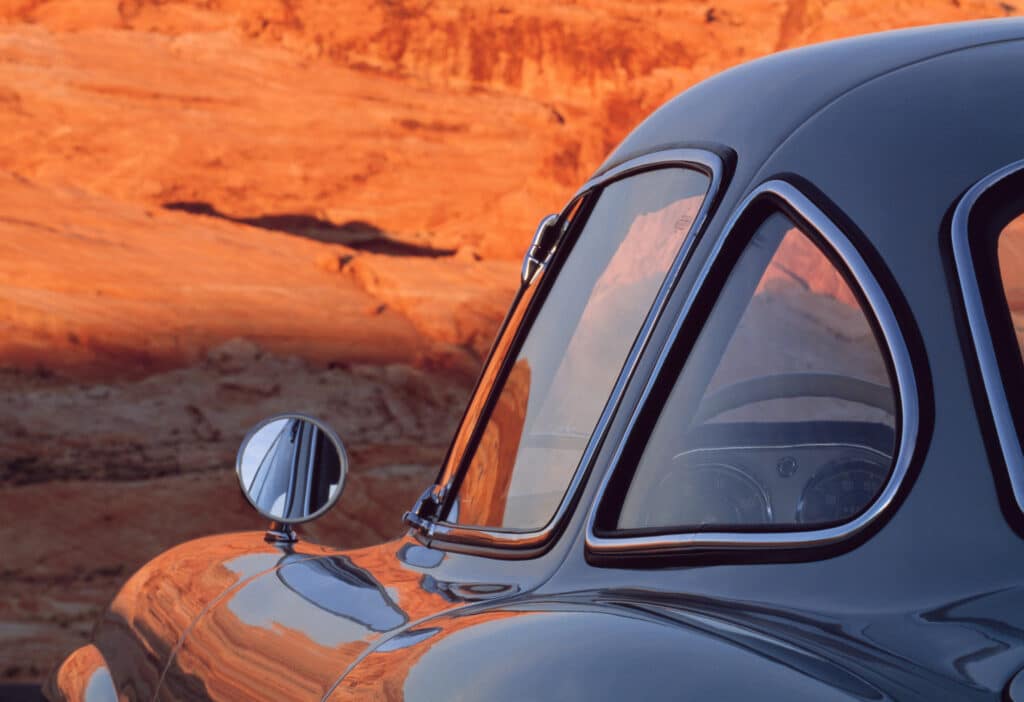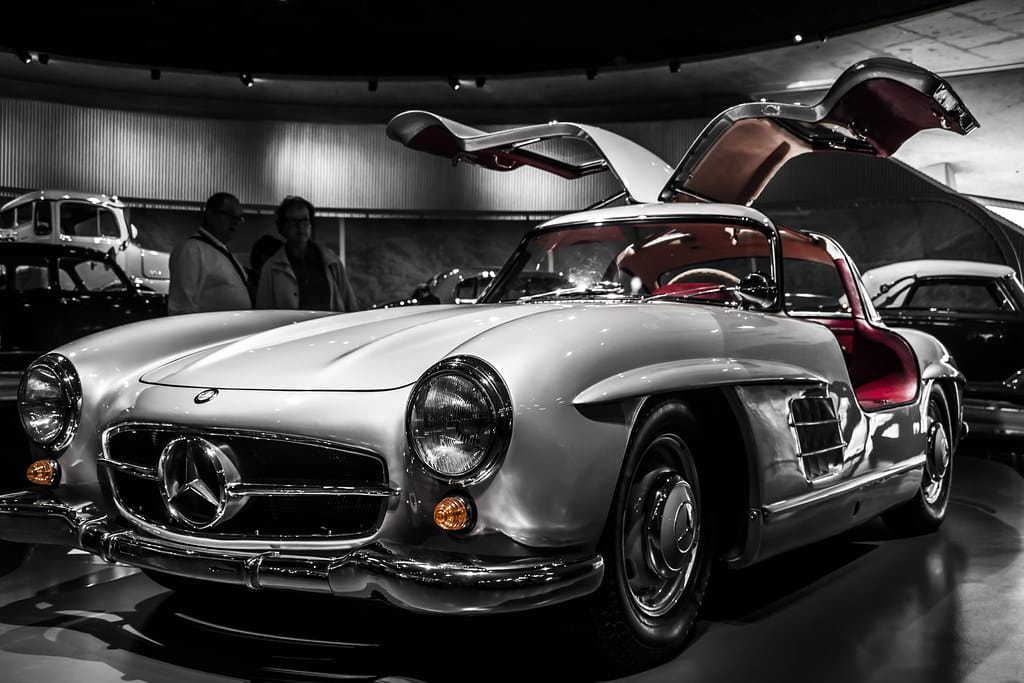Mercedes 300 SL Gullwing for sale
Introduction
The Mercedes-Benz 300SL Gullwing coupe made its public debut in February 1954 with stunning looks, iconic design elements, and the kind of racing pedigree that other vehicles can only dream of. The 300 SL story began with Mercedes-Benz’s 1952 racing car, the W194. Seeing the success the car enjoyed at circuits around the world and recognizing a unique business opportunity, Mercedes-Benz US importer Max Hoffman is credited with the inception of the car that would go on to become an icon of speed, luxury, and jaw-dropping design. The 300SL Gullwing was introduced to the public at the 1954 International Motor Sports Show in New York, breaking Mercedes-Benz convention of displaying new models at Frankfurt or Geneva as they came later in the year. The thinking behind this decision was to get the car in front of its American target audience and proved to be the right move because the motor show’s attendees heaped much praise on the beautiful new Mercedes-Benz design.
Hoffman recognized the market potential for a slightly detuned version of the W194 racer aimed at wealthy privateers and made his proposal to Mercedes-Benz executives in Germany. The proposal was accepted, and Mercedes-Benz allotted Hoffman a production run of one thousand 300SL Gullwings using the W198 chassis code. The 300SL was the first production car to feature the iconic gullwing doors, and with its top speed of 163 mph became the fastest car in the world at the time. The “SL” designation in the 300SL’s name comes from the German “super-leicht” meaning super light, in reference to the fact that the road-going coupe used the same lightweight tube-frame construction beneath its beautiful flowing bodywork. With extremely positive public reaction spurring it on, the Mercedes-Benz 300SL Gullwing coupe began production at the Sindelfingen plant near Stuttgart in August of 1954.
The foundation of the 300SL Gullwing was the lightweight, yet extremely strong, tubular steel frame which was attached to the car’s steel chassis. The large body sections of the body were also produced in steel, with the bonnet, doors, dashboard, and boot lid shaped from aluminium to further save weight. All told, the tubular spaceframe weighed just 82 kg, and made the now-iconic Gullwing doors a necessity thanks to the high door sills that were a byproduct of the frame’s design. The wide sills also allowed for the vehicle’s greenhouse to be tucked in away from the edges of the body, thus cutting down on frontal area and producing a more aerodynamic shape. The frame itself had been designed for the W194 racing car by Mercedes-Benz head engineer Rudolf Uhlenhaut, himself a decorated racing driver. Along the 300SL Gullwing’s flanks, the trademark “eyebrows” were styled above the front wheels to prevent water thrown up by the wheels from obscuring vision during bad weather, with the rear brows added for visual symmetry. Mercedes-Benz’s signature silver-grey paint came as standard, with other colours available as optional extras.
Working with the 300SL Gullwing’s sleek, aerodynamic design was a water-cooled 3.0 litre single overhead cam straight-six engine taken from the larger 300 “Adenauer” sedan which it had also shared with the W194 racing car. While the racer and sedan had made do with a carbureted setup, the 300SL Gullwing coupe was given a Bosch mechanical fuel injection system which boosted engine output. In keeping with the aerodynamic focus of the new coupe, the engine was canted 50 degrees over to the driver’s side of the car, keeping it low in the car for improved aerodynamics and a lower centre of gravity. This setup, coupled with the fuel injection system and the larger air intake it allowed, meant that the 300SL Gullwing produced a stout 240 horsepower. Again reducing the engine’s overall height, a dry sump oil lubrication system eliminated the need for an oil pan on the bottom of the motor, with a large 15 litre oil tank keeping the 300SL Gullwing cool whether it was racing or cruising on the winding American roads it was designed for. A four-speed manual transmission backed up the straight-six engine with a tall first gear that some drivers found challenging when driving in close city traffic.

The 300SL Gullwing also borrowed its drum brakes from the larger four-door 300S sedan. While the 300SL wouldn’t come equipped with disc brakes until the 1961 model year Roadster, the Gullwing’s drums were cutting-edge for its time with fins embossed into the brake housing’s outer casing. During spirited driving on the road or at the racetrack the fins would act as fans to keep the brakes within a safe operating temperature while the increased surface area provided by the fins also allowed for better heat dissipation. The 300SL Gullwing also featured a brake booster, also known as power brakes, which used vacuum pressure from the intake manifold to assist the driver and make pressing the brake pedal easier.
Another area where the 300SL Gullwing excelled was its suspension design with independent suspension at all four corners. Up front, the Gullwing received a set of double wishbones with coil springs and hydraulic shock absorbers providing confidence-inspiring steering, a smoother ride, and much better handling than other luxury cars at the time. At the back, the Gullwing was designed with a two-joint swing axle. In this design the axles are attached and pivot on either side of the centre differential with coil springs smoothing out bumps in the road. Due to the nature of the axles pivoting near the centre of the car, drivers could experience some fairly large changes in camber (the angle at which the wheels lean in or out from 90 degrees when viewed from in front or behind) and driving the 300SL on bumpy roads required caution at high speeds. At the end of each axle was a wheel made from steel and aluminium, with desirable optional wheels made by British company Rudge. The 300SL Gullwing sported tires that measured 6.5 x 15 inches.

The 300SL Gullwing’s beauty is more than skin deep, with a refined interior matching the grace of its exterior shape. Chequered pattern fabric upholstery in a choice of three colours came as standard, though most buyers chose the optional leather upholstery for seating. As mentioned above, the dash is made from aluminium to save weight and is accented by a gorgeous set of instrument dials. Due to the sharp angle of entry created by the high-riding door sills, the 300SL Gullwing features a steering wheel which tilts 90 degrees from its driving position to allow the driver easier ingress. The unique shape of the Gullwing doors means that the main side windows are fixed, with the cabin’s occupants able to get some fresh air thanks to pivoting triangular quarter windows at the front of the doors. Boot space is taken up by the fuel tank and spare wheel, so luggage rests behind the seats in the cabin. A pair of bespoke travel cases were available as an optional extra for the 300 SL Gullwing.
Perhaps unsurprisingly for a road car based so closely on a racing car, the 300SL Gullwing coupe’s racing prowess was proved time and again in some of the world’s most prestigious motor races. 1952 was an especially successful year. Beginning with a second and fourth-place finish at its first race, the 1952 running of the Mille Miglia, 300SL Gullwings went on to finish 1-2-3 at their next outing in Bern, Switzerland. Next came a 1-2 finish at the 1952 24 Hours of Le Mans followed by another 1-2-3 finish at the Nurburgring beating competition from Ferrari, Jaguar, and Alfa Romeo. For good measure the 300SL Gullwing claimed first and second at the gruelling Carrera Panamericana that same year. The 300SL Gullwing remained in production until the coupe version debuted at Geneva in 1957, and would go on to become one of the most beautiful, instantly recognizable, and collectible cars the world has ever seen.





